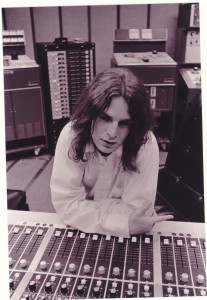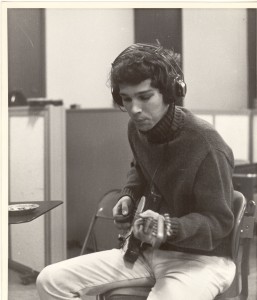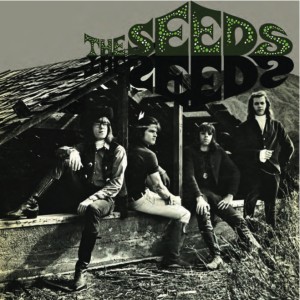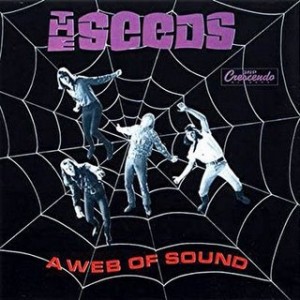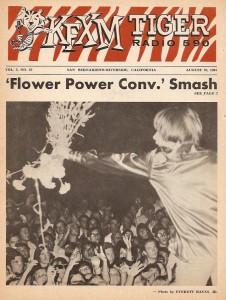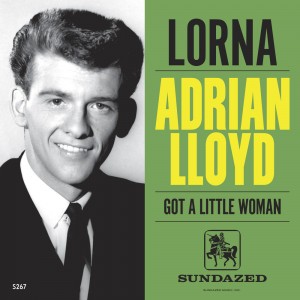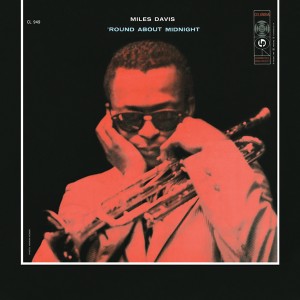-
Featured News
Patti Smith Upcoming Tour for 50th Anniversary of Horses
 By Harvey Kubernik
“Horses was like the first cannon blast in a war – frightening and disorienting. I mean, she was so unlike the FM radio terrain in every way. She was literate, aggress
By Harvey Kubernik
“Horses was like the first cannon blast in a war – frightening and disorienting. I mean, she was so unlike the FM radio terrain in every way. She was literate, aggress -
Featured Articles
Chasing the White Light: Lou Reed, the Telepathic Secretary and Metal Machine Music
 By David Holzer
Fifty years ago, Lou Reed released Transformer. In among “Walk on the Wild Side,” “Make Up” and “Vicious,” cuts that would launch a cartoon Rock N Roll Animal pers
By David Holzer
Fifty years ago, Lou Reed released Transformer. In among “Walk on the Wild Side,” “Make Up” and “Vicious,” cuts that would launch a cartoon Rock N Roll Animal pers -
What’s Missing in Music Bios? Often What’s Great About the Music
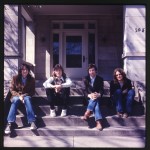
By Bill Wasserzieher
The problem with many documentaries about solo artists and/or bands is that they “print the legend,” to lift that old line from John Ford’s The Man Who Shot Liberty Valance. That is, filmmakers, being storytellers, flesh out the accepted version of their subject’s career—and that’s good for what it is, overviews being useful for the uninitiated—but rarely do they dive deep for what is at the core of the actual art.
To put it another way, is there even one among the scores of Dylan documentaries that digs into his songwriting process? I’d love for the hire-by-the-hour “talking heads” who pop up in them to focus on the creative vision that, for example, produced “Just Like Tom Thumb’s Blues.” Think about those opening lines:
When you’re lost in the rain in Juarez and it’s Easter-time too, And your gravity fails and negativity don’t pull you through, Don’t put on any airs when you’re down on Rue Morgue Avenue, They got some hungry women and they’ll really make a mess out of you.These are maybe the bleakest lines since T.S. Eliot was ruminating on “The Hollow Men” and “The Wasteland.” But, no, we always hear about young Bob scuffling in the Village, courting Joan Baez, going electric, retreating to Woodstock, finding/losing/finding religion, ad infinitum. Instead, tell me about those carbolic lines and how his etched-with-acid voice shoves them to the gut.
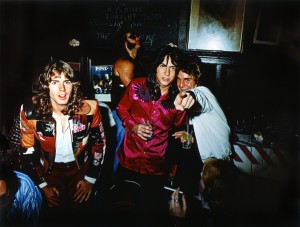
Jody Stephens, Andy Hummel and Alex Chilton. (Photo courtesy of Magnolia Pictures. Photo credit: William Eggleston, Eggleston Artistic Trust)
This problem comes to mind with the new and very competently made documentary Big Star: Nothing Can Hurt Me (Magnolia Pictures). The filmmakers present nearly a two-hour overview of a band whose members were young white guys from Memphis—one a former teenage hit-maker with the Box Tops—who cut an indisputably great album, #1 Record, that went unnoticed; followed by another, Radio City, nearly as good and equally ignored; and then a third, Sister Lovers, which was never actually finished, as the players drifted off to different and mostly sad, bad fates.
The filmmakers get the Big Star story from the band drummer Jody Stephens and bassist Andy Hummel, from friends and relatives of deceased members Chris Bell and Alex Chilton, their Ardent recording studio associates (Ardent headman John Fry is the film’s executive producer), an array of rock critics (including a funky old Lester Bangs clip), plus numerous praise-wielding musicians, among them Jim Dickinson, Chris Stamey, Mike Mills, Robyn Hitchcock and Ken Stringfellow.
No denying it’s a well-crafted overview, but what’s missing is serious analysis of the songs and the musicianship on No. 1 Record. What are those songs about? What do say about life as Chris Bell and Alex Chilton were experiencing it, their individual and sometimes at war psyches (Bell bipolar and troubled by sexual identity issues, Chilton bitter, caustic, frequently loaded), and how did their minds and voices work together and separately? These are things crucial to the Big Star story. Otherwise the band was just one of millions that arguably could have been the new Beatles but were not, though at least this one became famous after the fact and served as a fountainhead for power-pop bands that came later.
Plus the documentary, while keeping with the legend, plays it cautious. Nowhere is the Alex Chilton I met a few times, first in New York City during the late 1970s when he had a loose ensemble called the Cossacks. One night I asked him about the Big Star records, and he responded, “Fuck that old shit.” Nearly 25 years later, after he and Jody Stephens reformed Big Star with members of The Posies, I cornered him after a solo show at McCabe’s in Santa Monica, where he had intentionally bummed out a capacity crowd hoping to hear a few Big Star and/or Box Tops tunes by playing instead “Volare” (“Nel blu dip into di blu”) and other songs better suited to a Dean Martin tribute. I asked him why, and he said, “I hate my fans.” Sometimes an artist is his own worst enemy, but Big Star: Nothing Can Hurt Me doesn’t say so.
And that brings to mind those purveyors of commercial/corporate rock, the Eagles. At least the documentary History of the Eagles manages to do more than provide the standard career recap. Glenn Frey, the film’s executive producer and primary talking head, spends three hours trashing everyone who has ever rubbed him wrong—producer Glyn Johns who got the Eagles their first hits, former bandmates Bernie Leadon and Randy Meisner (whose previous stints in Dillard & Clark, the Flying Burrito Bros. and Poco gave the Eagles early credibility), original manager and label boss David Geffen, even Timothy B. Schmit and Joe Walsh who are still contracted sidemen in the band, and especially Don Felder who is reduced to tears when interviewed on how he came to be kicked out.
According to Frey, only he and Don Henley really matter in the grand scheme of things—and that’s why he’s proud to say they get bigger bucks than the others, money apparently his ultimate gauge for success. At no time does Frey ever seem to see beyond his own ego, coming off as vengeful, arrogant and self-absorbed. It’s fascinating and twisted, as creepy as watching footage of performance artist Chris Burden nail himself to the hood of a VW Beatle. But at least it’s more than just another example of “print the legend,” and we do learn something about his band’s songcraft, including that Frey dreamed up the title “Life in the Fast Lane” while roaring through Hollywood at 90 mph in a Corvette driven by his dope dealer on their way to a poker game.
In issue #36 of Ugly Things, Alan Bisbort has a review of a DVD titled A Band Called Death. Comprised of three African-American brothers from Detroit who played rock rather than Motown, the band was good enough for Clive Davis, then the head of Columbia Records, to offer to sign them if they would change their name to something less of a sales-killer than Death. But they wouldn’t, so he didn’t. Now that’s a legend new for the telling. Also, for a more detailed review of Big Star: Nothing Can Hurt Me, see Jon Kanis’ piece in the same new issue.
Reaching for the Sky — Ace Reissues Roll Out the Red Carpet for the Seeds
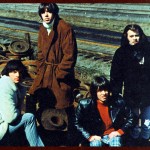
By Doug Sheppard
It’s fitting that the Seeds have been retrospectively described as punk — as their history is nothing if not punk before punk. Their wildly contrasting attire of cowboys ’n’ Indians ’n’ Beethoven confounded audiences, their (for 1965 and 1966) outrageously long hair literally turned heads, and their primitive music made the most of members’ limitations. A decade before Johnny Rotten’s snarl set the tone for modern punk, Sky Saxon’s snide snorting added a distinction that obliterated his previous teen idol failures.
But where the Seeds depart from their punk descendants is that they were reaching for the (pardon the expression) sky. Minimalistic as their sound may have been, they were serious artists doing their part to add brushstrokes to a rock ’n’ roll canvas with plenty of unpainted room left. They were a popular band in their native LA, and proud of it – proud of the adulation, proud of their tight musicianship and proud that they scored a major hit with “Pushin’ Too Hard” in ’66. By practicing rigorously and mostly ignoring contemporaries, the Seeds forged their own sound.
Though they couldn’t have known it at the time, they also chose a great record label to keep their legacy alive: GNP Crescendo. As the big fish in GNP’s pond, they ensured themselves immortality. As albums by fellow ’60s punks like Question Mark and the Mysterians, the Sonics, the Shadows of Knight and countless others became pricey and difficult to obtain through the dark pre-reissue days of the ’70s and ’80s, the Seeds catalog was always available — making them one of the first ’60s garage bands that many fans discovered. Heck, long before outtakes albums became the norm, GNP even did one of those with Fallin’ Off the Edge in 1977.
Ironically, in spite of their perpetual availability, Seeds albums never got the deluxe treatment that their once out-of-print colleagues received in the reissue era. All reissues of the first Seeds album used the inferior stereo mix, pressings of A Web of Sound from the 1970s and beyond used an awful alternate stereo mix that wasn’t even on original stereo pressings, and the packaging left a lot to be desired. But all is forgiven now that the vaults have been opened to Ace Records and its garage archivist Alec Palao – resulting in proper mixes, remastered sound, bonus tracks, and extensive booklets with detailed liners, sessionography and many cool photos.
Availability alone doesn’t account for why the Seeds are one of the most renowned ’60s punk bands. They’re also one of the best – and their debut album is as good a place as any to start a ’60s garage education. With Sky’s frustrated vocals, Rick Andridge’s insistent ride-cymbal beat, a killer fuzz riff and tersely great solos by organist Darryl Hooper and guitarist Jan Savage, “Pushin’ Too Hard” remains a crowning achievement in rock history – and it’s not the only standout on the album. “No Escape,” “Girl I Want You,” “Nobody Spoil My Fun” and “Excuse, Excuse” sum up the band’s burgeoning hedonism and Sky’s affinity for the opposite sex, and the five-minute “Evil Hoodoo” dips their feet into the experimentalism of the extended groove.
“Evil Hoodoo” was in fact much longer in its original unedited form, and this reissue treats us to a 16-minute version (with an intercut section) that loses nothing in translation and is a highlight of the 10 bonus tracks (eight of which are previously unreleased). The two alternates of “Out of the Question,” “Pushin’ Too Hard” with an extra verse and “It’s a Hard Life” with more of Savage’s guitar savagery also make nice addenda. Best of all, the album’s original — and far superior — mono mix is reissued for the first time ever here.
A Web of Sound gets similar treatment from Big Beat – expanding to two CDs to restore the album’s original stereo and punchy mono mixes, adding seven previously unreleased bonus tracks and the complete A Full Spoon of Seedy Blues album (released as the Sky Saxon Blues Band). While Web has nothing on the level of “Pushin’ Too Hard,” it’s nonetheless a step forward for the band’s creativity with bottleneck guitar by Cooker providing counterpoint to Savage throughout — not to mention the brilliant “Mr. Farmer,’ where Hooper overlays oboe-like Farfisa sounds over his trademark Wurlitzer piano. Punk like “Tripmaker” and “Just Let Go” provide further highlights on album culminating with one of the first extended jams on a rock album: the simple yet hypnotic “Up in Her Room.” The latter reflects the album and the Seeds in general: repetitive and same-y sounding, yet effective because they deployed their sound so well.
An early take on “The Wind Blows Your Hair” is the best of the bonus tracks, while alternates of five album tracks also make for interesting (albeit not essential) listening. Though the original stereo mix is much better than the alternate stereo that afflicted 40 years worth of Web of Sound reissues (in all formats), the mono version (another first-ever reissue) is the keeper.
A Full Spoon of Seedy Blues is also represented in mono – but the mix is beside the point. Much as the members seem to take pride in their attempt at blues, the results are lackluster – and even guest spots from members of Muddy Waters’ band and a new song written by Muddy himself for the Seeds (Did he give them one of his best? Let me guess …) can’t rescue this mess. Tellingly, it’s the only ’60s Seeds album that Big Beat has no plans to reissue individually.
But with A Web of Sound finally reissued the way it was meant to be heard, it doesn’t matter. Even better — Big Beat isn’t finished with the Seeds yet, as an expanded remaster of Future just came out (it will be reviewed in UT#36), with Raw & Alive and a singles collection – not to mention a documentary film spearheaded by Palao and GNP’s Neil Norman – soon to follow.
Seeds on Sundazed — and other Record Store Day Scores
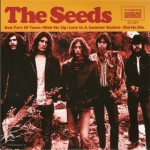
By Doug Sheppard
Like the authorities catching up to the protagonist in a biker exploitation film, time had caught up to Sky Saxon in 1970. Between Altamont, harder drugs and the frowning faces of war protestation, there was no room for the Seeds’ idealism and – if analogies are in order – the times had indeed spoiled Sky’s fun. Rock was now serious, like really serious, man — discovering all kinds of wimpy folk, phony roots, long solos and (thanks to Woodstock) corporate influences. Sky was Davy Crockett at the Alamo – or rather, a rocker past him prime getting laid a lot at his Malibu home. But it didn’t mean he didn’t have one last charge in him.
Calling on old keyboard sidekick Darryl Hooper, plus three new members, the re-sprouted Seeds departed GNP Crescendo for MGM and recorded two killer singles that sadly never made it past the promo stage, falling into permanent rarity status and never getting a legit reissue – until now, thanks to Sundazed and Record Store Day.
The Seeds’ first MGM offering, “Bad Part of Town” b/w “Wish Me Up,” paired a biting fuzz rocker with a more flowery, keyboard-dominated number that harked back to the band’s later GNP material. It was the heavy influence of “Bad Part of Town” that would propel the even better followup, “Love in a Summer Basket” b/w “Did He Die.”
In spite of its title, “Love In a Summer Basket” isn’t so much a floral excursion as it is a tidal wave of loud fuzz guitar squalls crashing the shores of idealism as keyboards and flute weave in and out. Perfection. And if that trip isn’t bad enough, then the war-torn flip of “Did He Die” – rumbling bass, screeching guitar distortion and all — blurs visions even more, as Sky lets the Vietnam anxiety out by screaming “He shot him in the head! He killed his bro-ther-ah-ah-ah-ah” without fear of pushing too hard.
But when MGM President Mike Curb purged his label of acts with drug influences (like the Seeds) just two days before its release, he denied the world what would undoubtedly have been the finest Seeds album yet. (The Seeds would go on to make one more great indie single the next year, “Shuckin’ and Jiving” b/w “You Took Me By Surprise,” two barnstorming rockers that up the heavy ante even more.)
This Sundazed gatefold double-single set not only replicates the sound of the originals thanks to use of master tapes, but also offers a great essay by Seeds scholar Jeff Jarema that finally reveals the names of the other musicians (outside of Saxon and Hooper) on the MGM sessions, plus some really cool vintage photos. File under “must have.”
Speaking of screaming punks, Sundazed has unleashed another punk killer among its RSD releases, the lasciviously lustful “Lorna” by Adrian Lloyd. Busting and burning the surfboards he brandished in the Rumblers and the Sunsets, Lloyd unloads a torrent of tribal drums, snotty vocals and screams (“approximately 25,” sez Jarema in the liners) for a rightly regarded classic getting its first reissue on a seven-inch. Possibly (and if so, justifiably) winded, Lloyd is a little more restrained on the B-side, “Got a Little Woman,” a groovy rocker with “woah yeah” call-and-answer vocals that’s pretty cool in its own right.
No discussion of screaming rock ’n’ roll would be complete without the Trashmen, who rode it into the Top 10 with the infamous Rivingstoned rant “Surfin’ Bird” in 1963. By 1966, the hits had dried up, the British had come, and a trip was about to be taken, but the Bird men defiantly stuck to rock ’n’ roll — as evidenced by the live versions of “Mean Woman Blues” and “Big Boss Man” on this RSD single on Sundazed, which has done more than perhaps anyone else in spreading the Trashmen gospel.
SONY LEGACY
Sundazed head Bob Irwin’s other employer, Legacy, also did some great releases for Record Store Day – the best unquestionably being the 180-gram vinyl reissues of the mono mixes of three vintage Miles Davis albums: ’Round About Midnight, Milestones and Someday My Prince Will Come. Housed in sharp reproductions of the original covers, the sound emanating from the grooves is nothing short of stunning – presenting the material with a clarity that almost feels like being in the studio with Miles, John Coltrane, Philly Joe Jones and (on Milestones) Cannonball Adderly.
Much has already been written about Miles’ first and third Columbia offerings, ’Round About Midnight and Milestones, respectively, what with the all-star lineup and groundbreaking evolution of hard bop into modal jazz – not to mention classics like the rearranged version of Monk’s “ ’Round Midnight” on the former and the swinging title track of the latter. So that leaves the mono vs. stereo question and, to these ears, much as I enjoyed the stereo CD remasters, the more intimate sound of the mono mix is preferable.
Released on the heels of two landmarks, Kind of Blue and Sketches of Spain, Someday My Prince Will Come was bound to suffer in comparison. But it’s a fine album in its own right, thanks to all of the Kind of Blue lineup save Adderly and Bill Evans — although here the mono mix is more of an alternative for collectors.
Legacy has also given us 10 inches of previously unreleased Sly and the Family Stone at their peak, including “Music Lover/I Want to Take You Higher/Music Lover” from the Isle of Wight Festival in 1970, the rare promo-only single version of “Higher,” and a TV medley of “Sing a Simple Song/Hot Fun in the Summertime/Sex Machine/I Want to Take You Higher” from 1969. Nice to have, but the best news is the insert in this I Want to Take You Higher EP noting the upcoming release of a four-CD Sly box set with rarities and 18 previously unreleased tracks.
BELATED BLACK FRIDAY
Black Friday has become to Record Store Day what Labor Day is to Memorial Day – and spotlighted some worthy limited editions of its own the last time around, including a self-titled 12-inch four-song EP by Eric Burdon & the Greenhornes on Readymade. Old-meets-new affairs usually signify guest appearances on remakes, so I’m pleased to note that this is not only all new songs — but the best music that both Burdon and the Greenhornes have made in years. Hard rockers (“Black Dog,” not the Zeppelin or even Timebox track), slow blues (“Out of My Mind”) and flat-out rockers (“Can You Win”) fire up a package that makes one wish for a full-length. Age can be detected in the old Animal’s voice, incidentally, but like the bluesmen he’s long idolized, it’s fine seasoning, not wear.
Also worthy of investigation is Secret Stash’s single by the Prophets of Peace, “P.O.P” b/w “46th Street Bump Time.” From the same 1974 session that produced one side of their lone single (included on Twin Cities Funk & Soul, reviewed in the upcoming issue) comes this previously unreleased pairing of two fine Tower of Power-styled horn soul groovers: a vocal number on the top side and an instrumental on the flip. Limited to 500 copies.
